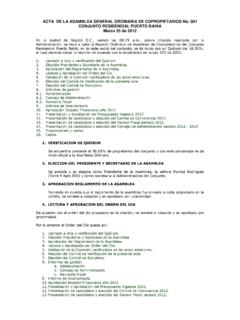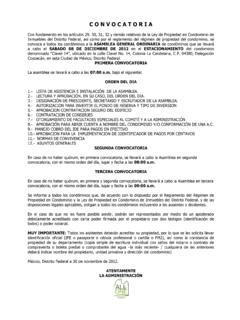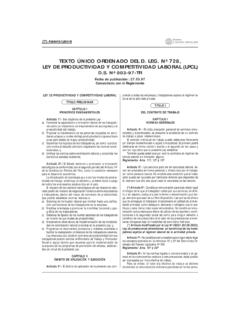Transcription of JUSTINIANUS, Institutiones; ACCURSIUS, Glossa …
1 justinianus , institutiones ; accursius , Glossa ordinaria ( unfinished ) In Latin, illuminated manuscript on parchment Southern France, perhaps Toulouse , c. 1290-1300. 51 ff., with last folio a former flyleaf, apparently complete (collation: i6, ii-iv8, v10, vi8, vii3), on parchment, with two distinct hands and decorators (ff. 1-30v; ff. 31-50v), written in a fine French version of littera bononiensis (at least two hands), in brown ink, text in 2 columns (justification 232 x 130 mm.) with surrounding gloss (justification: 320 x 230/235 mm), first two quires (ff. 1-14v) with marginal gloss, after f. 15 annotations are more scarce and gloss has not been copied, decorated catchwords in brown ink (some with anthropomorphic features, mermaid in lower margin of f.)
2 22v, prickings still visible in the outer margin of leaves, some early stitching to repair parchment with blue thread, rubrics in red, some guide words for the rubricator, spaces left vacant for rubrics or decorated initials ( unfinished ), lemmata in gloss underlined in brown ink, paragraph marks in alternating red or blue, marginal and interlinear gloss (some interlinear gloss might be textual corrections), manicula and doodles in the margins (some with faces), 66 decorated highly finished initials up to 4-line high in blue or pink on opposite color grounds with colored foliate or floral infill with burnished gold, some with rinceaux and foliate motifs extending into the margin, a few inhabited with grotesque figures (first campaign of decoration, ff.)
3 1-30v), change of decorated initials in second campaign of illumination (beginning f. 31 till the end) with more modest initials only 2-line high of highly burnished gold on blue grounds with pink infill highlighted in white, 1 HISTORIATED INITIAL (f. 1) placed below the miniature, 4 COLUMN-WIDE MINIATURES (ff. 1, 9v [one face defaced, 24, 37], opening leaf with long decorative colored baguettes with swirling acanthus leaves that descend and separate the columns, creating something of a frame, with two figures at top [figure with a sword; figure with a horn and bagpipe] (with the exception of the miniature, the decoration of the frontispiece leaf is clearly conceived in imitation of Italian Bolognese illuminated codices), heraldic shields found on f.
4 1 (repeated twice, larger arms in the bas-de-page between two birds (added later)), f. 24. Modern full vellum binding (acidity of ink has damaged the parchment in a few instances, some leaves cut shorter with the removal of lower (blank) portions of the margins, e. g. ff. 31-34; some early parchment reparations, some holes in animal hide reflected in parchment, some internal staining). Dimensions 410 x 260 mm. Fine illustrated copy of Justinian s Institutes, a text that served as a manual for students of law and became an authoritative source of Roman Law. There are four miniatures, one introducing each of the four books. A place of origin in Toulouse, one of several places of production for legal manuscripts, seems likely.
5 The annotations and supplementary glosses and corrections that pepper this codex merit further study. This codex constitutes an excellent example of the different stages in a given decorative program. PROVENANCE 1. Manuscript decorated in two different or separate campaigns: the first portion of this codex (ff. 1-30v) sports very polished decorated initials in bright blue and pink, with foliate red and blue foliate infill, apparently meant to be part of the first campaign of illumination. The second portion of the codex (ff. 31-50v) was copied perhaps only very slightly later, in imitation of Italian ornament. There remains nonetheless a coherent style amongst the four miniatures which are distributed in all quires, with both decorative campaigns.
6 This leaves us with the possibility that the decorative phases (initials, rubrication) and even textual phases (note the interruption, rather abrupt, in the gloss that fills only the first 14 leaves, might have been interrupted or abandonned . The miniatures would thus have been part of the very first phase in the decorative program, which would account for their coherence in style (although there are presumably two different hands involved). The codex appears to have been copied in France, with a possible place of origin in southern France, probably south-western France. Tentatively we suggest Toulouse as a possible place of production for this codex. Indeed, the present codex affords comparisons with other codices tied to Toulouse such as a Dominican Missal (Toulouse, BM, MS 103), discussed by Stones, in [Exhibition].)
7 Le parement d autel des Cordeliers de Toulouse (2012), pp. 51-52; see also the Decretum of Gratian (Avignon, BM, MS. 659), c. 1320, see Stones, 2012, p. 51. There was a vibrant legal community and university in Toulouse, a city in need of legal manuscripts for practice and study. The composition of most of the quires in gatherings of eight (8) corroborates the French origin of this manuscript, as well as the practice of underlining the lemmata in brown ink. There are heraldic elements found in this codex, that merit further study as we have not yet secured identification. The first leaf contains repeated twice the following arms : de gueules au croissant montant d or. The arms are found in the lower margin, between two birds (added later).
8 They are also repeated beneath the historiated initial representing a scribe at work. Could they be the arms of the cleric? Oddly, other arms are found on f. 24, again repeated twice, but with reversed colors: d or au croissant montant de gueules. One of the shields adds a lambel and are described as follows : d or au croissant montant de gueules au lambel d azur. Further research might allow for proper identification of these arms. There are many candidates. For instance there is Guillaume de Mordelles, seigneur de Chateau-Goello, c. 1300: de gueules au croissant montant d or (La Chesnaye-Desbois, X, Paris, 1775, p. 464; Pol Potier de Courcy, Nobiliaire et armorial de Bretagne, Rennes, 1890, entry Mordelles ou Morzelles (de), t.)
9 II, p. 300). This could fit, but there are a number of other families that bear these arms. 2. Numerous inscriptions, contemporary or near-contemporary (14th c. hands) are found on the back flyleaf (ff. 51-51v) luckily preserved. Most of the notes relate to points of law. However one reads In ista institutiones sunt 51 folia (f. 51); In hoc volumen sunt per 6o [sexto] clemen[..] instituta 89 folia (f. 51). In the lower righthand corner of f. 51, one reads an ownership inscription (early 14th c. hand): Iste liber est [dilecte] (?) capina (?) can[onici] avin[ionensis] (f. 51). The reading of Avinionensis (for Avignon) is suggested here but can be read with great difficulty.
10 Ultraviolet light might allow for a better reading. TEXT ff. 1-9v, justinianus , institutiones , Book I, Preface, rubric, In nomine domini nostri jhesu christi cesar flavius justinianus alamanicus goticus germanicus ala,icus vindalicus affricanus pius felix inclitus victor ac triumphator semper augustus romani legum expositor institucionum seu helementorum liber primus incipit; incipit, Imperatoriam maiestatem non solum armis ; incipit Book I, rubric, De iusticia et iure; incipit, Iustitia est constans et ; explicit, [..] removendus non est [quasi suspe]ctus (ed. Krueger and Mommsen, Corpus Iuris Civilis, Hildesheim, 2000, pp. 1-10); ff. 9v-24, justinianus , institutiones , Book II, rubric, Incipit liber.






